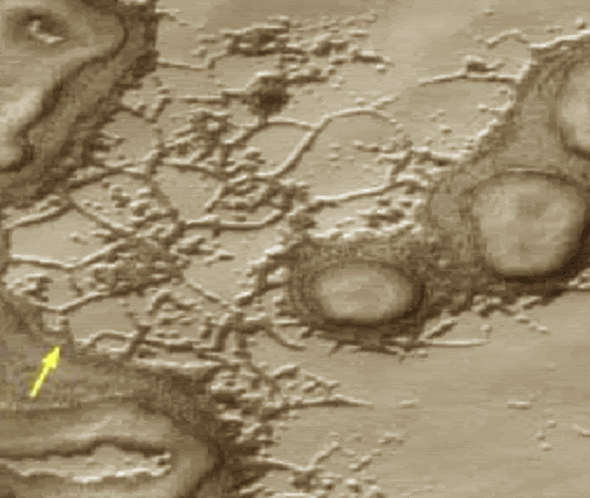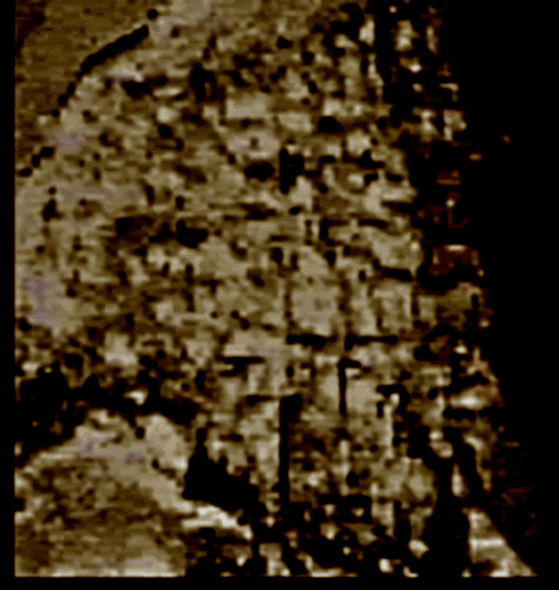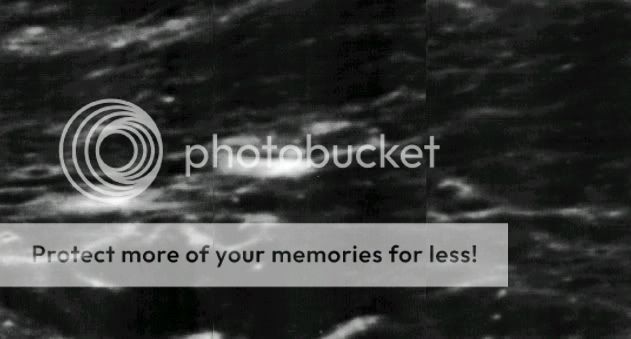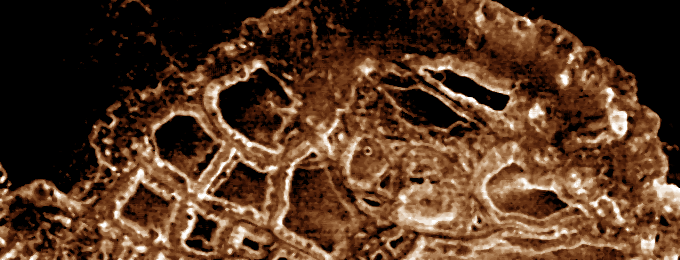It looks like you're using an Ad Blocker.
Please white-list or disable AboveTopSecret.com in your ad-blocking tool.
Thank you.
Some features of ATS will be disabled while you continue to use an ad-blocker.
share:
Originally posted by ArMaP
Symmetric was a wrong choice of words, but at the time (and even now) it was the best I could find in my mental dictionary.
"Inca city" features look more like a grid (finally I found the word that I wanted since yesterday) and are a "bas relief" instead of a "haut-relief" like those from the ESA photo.
Oh man!! Are we dealing with semantics here or alleged alien civilizational ruins??
Cheers!
ArMap, yesterday after my post i was trying to realize what you meant, and conclusively this was my thought (but of course i had to wait for your
confirmation) . And yes, inca city has still unique features (like the complex grid you mentioned), and its complexity hasn't still been
"overtaken" by other findings. And a conmaprison can be made basing it only on it external appearance (i mean the one of the surface):
i still haven't found other formations with a circular base like inca city.
[edit on 14/12/2007 by internos]
i still haven't found other formations with a circular base like inca city.
[edit on 14/12/2007 by internos]
Originally posted by internos
i still haven't found other formations with a circular base like inca city.
Internos, I think that circular formation is due to the crater. If you look carefully, you'll notice that the 'city' is 'built' along the edges of a crater that has been filled up by ejecta etc. It's not built into a circular shape ab initio.
What do you think of this nighttime infrared image of a portion in Hydaspis. Pretty strange formations, what??
Photo credit: NASA/JPL/Arizona State University
www.spaceref.com...
Originally posted by mikesingh
Internos, I think that circular formation is due to the crater. If you look carefully, you'll notice that the 'city' is 'built' along the edges of a crater that has been filled up by ejecta etc. It's not built into a circular shape ab initio.
What do you think of this nighttime infrared image of a portion in Hydaspis. Pretty strange formations, what??
Heck, i wish to have more infrared images of certains areas:
Hydaspis Chaos looks totally different in ordinary images ...
nssdc.gsfc.nasa.gov...
I've never seen anything like that in a natural form. 90 degree angles just do not pop up everywhere in nature. Sorry this was made and not formed. I
can see the Jpeg artifacts and it does not look like that is making the 90 degree objects. It's not pixalated either because I see smooth surfaces.
Now I know Nasa is covering up something.
reply to post by mikesingh
If we are talking, then semantics are very important to our understanding, that is why I spend so much time just trying to make simple answers, but sometimes I fail to do it, even in Portuguese.
Mas se quiseres facilitar a nossa comunicação podemos falar em Português, para mim seria muito mais fácil.
(Translation)
But if you want makeour comunication easier we can speak Portuguese, it would be much easier for me.
If we are talking, then semantics are very important to our understanding, that is why I spend so much time just trying to make simple answers, but sometimes I fail to do it, even in Portuguese.
Mas se quiseres facilitar a nossa comunicação podemos falar em Português, para mim seria muito mais fácil.
(Translation)
But if you want makeour comunication easier we can speak Portuguese, it would be much easier for me.
Originally posted by ArMaP
Mas se quiseres facilitar a nossa comunicação podemos falar em Português, para mim seria muito mais fácil.
(Translation)
But if you want makeour comunication easier we can speak Portuguese, it would be much easier for me.
O português é como o grego a mim! Mas nós podemos dar-lhe uma tentativa!!
Cheers!
There's a very intersting find by Anhinga in this thread:
"Strange object found on Mars"

hirise-pds.lpl.arizona.edu...
[offtopic]
ArMap: you know, portuguese has many resembleace with my dialect: my dialect helps me more than my language in order to understand (a little bit) portuguese
[/offtopic]
[edit on 14/12/2007 by internos]
"Strange object found on Mars"

hirise-pds.lpl.arizona.edu...
[offtopic]
ArMap: you know, portuguese has many resembleace with my dialect: my dialect helps me more than my language in order to understand (a little bit) portuguese
[/offtopic]
[edit on 14/12/2007 by internos]
Originally posted by internos
[edit on 14/12/2007 by internos]
Its a shadow, look at the shadows all around the map. You will then see that this is a pillar tha makes a shadow that looks like a square.
added curves to the image and enhanced the darken area, you will there see the structure in the shadow.
[edit on 14-12-2007 by tep200377]
reply to post by cloakndagger
More 90 deg angles! How come the 'walls' turn WITHOUT any obstruction? They should continue in the direction they were 'flowing' if they were in a molten or liquid state before solidifying. And how is it that there is no accretion where one 'wall' intersects the other? It just continues on the other side!!
But then probably Mars geology is presently way beyond our understanding!

Mars South Polar Region.
Courtesy: MSSS
OR, is it the remains of a city, partially buried under the surface?? Your guess is as good as mine!!
Cheers!
[edit on 15-12-2007 by mikesingh]
More 90 deg angles! How come the 'walls' turn WITHOUT any obstruction? They should continue in the direction they were 'flowing' if they were in a molten or liquid state before solidifying. And how is it that there is no accretion where one 'wall' intersects the other? It just continues on the other side!!
But then probably Mars geology is presently way beyond our understanding!

Mars South Polar Region.
Courtesy: MSSS
OR, is it the remains of a city, partially buried under the surface?? Your guess is as good as mine!!
Cheers!
[edit on 15-12-2007 by mikesingh]
Here’s an image taken by Phobos 2 of what looks like a city on Mars in the Hydraote region.

Courtesy: Enterprise Mission
I’ve added some contrast and color to see what it looks like! So here’s what emerges…

Looks like the ruins of an ancient city, what? It could be pixelation too!!
Cheers!
[edit on 15-12-2007 by mikesingh]

Courtesy: Enterprise Mission
I’ve added some contrast and color to see what it looks like! So here’s what emerges…

Looks like the ruins of an ancient city, what? It could be pixelation too!!
Cheers!
[edit on 15-12-2007 by mikesingh]
Originally posted by mikesingh
Here’s an image taken by Phobos 2 of what looks like a city on Mars in the Hydraote region.

Courtesy: Enterprise Mission
You know, that would be a really intriguing picture there, all except for one small thing. If you notice, under the enlarged part, it says 2 km/Pixel Resolution. I do believe that means that each pixel in that image is 2 km wide. If that's the case, then we must assume that those are some of the universe's largest intelligently-designed structures. Either that, or they're just really cool looking surface features.
But I digress, I've been wrong far too much of late to start being right all of a sudden.
TheBorg
Originally posted by TheBorg
...it says 2 km/Pixel Resolution. I do believe that means that each pixel in that image is 2 km wide. If that's the case, then we must assume that those are some of the universe's largest intelligently-designed structures. Either that, or they're just really cool looking surface features.
Yeah! That's what caught my attention whilst looking at it! Or is it 2m per pixel?? Or as you said, that would otherwise be the biggest goddamn city in the Solar System!!
reply to post by mikesingh
I don't think that they are ruins and I don't think it's a pixelation effect either, I think it's just lack of resolution on an image with many small details.
More recent images from that area show that, as its name suggests, that area has many features that look like the result of erosion by liquid.
The images below are from NASA's WorldWind using images from the MOC geodesy campaign.


From THEMIS (thermal)

And from the MDIM 2.1 (with photos from the Viking orbiter)

So, once more, it only looks like a city (maybe) when viewed in a very low resolution.
That is one thing I don't like about Enterprise Mission, they do not update their data when it does not help their point of view.
I don't think that they are ruins and I don't think it's a pixelation effect either, I think it's just lack of resolution on an image with many small details.
More recent images from that area show that, as its name suggests, that area has many features that look like the result of erosion by liquid.
The images below are from NASA's WorldWind using images from the MOC geodesy campaign.


From THEMIS (thermal)

And from the MDIM 2.1 (with photos from the Viking orbiter)

So, once more, it only looks like a city (maybe) when viewed in a very low resolution.
That is one thing I don't like about Enterprise Mission, they do not update their data when it does not help their point of view.
Originally posted by ArMaP
That is one thing I don't like about Enterprise Mission, they do not update their data when it does not help their point of view.
Agreed! Well, that's old Hoagy for you!! But darn, he's a celebrity! Even The History Channel shows his mug at times!
And yeah, about the low res explanation. I bite!
Cheers!
Oy what a mix of images This will take a while...
Okay a little more into the mix
Air view of the Ancient Assyrian ruins of Assur, good ole planet Earth...

The ancient Khorezmian fortress Koy-Krylgan-kala appeared as an impact crater on the air photo (left); its artificiality is obvious after the excavations in 1956 (right) Also Planet Earth

Now think about this in relation to "Inca City" and the Rectangle area Internos pointed out....
Now I have seen a lot of negativity expressed here towards Mike's finds...
But he is in fine company ( And I don't just mean at Pegasus )
SETI
On Lunar Archeology
What do they look for? EXACTLY the kinds of areas we have been discussing here....
Archaeological Reconnaissance of the Moon: Results of SAAM Project
Dr. Alexey V. Arkhipov ([email protected])
Institute of Radio Astronomy, Nat. Acad. Sci. of Ukraine
spsr.utsi.edu...
For those of you who now what books are and are not afraid of them
Additional reading:
Arkhipov, A.V. “Earth-Moon System as a Collector of Alien Artefacts”, J. Brit. Interplanet. Soc., 1998, 51,
181-184.
Arkhipov, A.V., and Graham, F.G. “Lunar SETI: A Justification”, in The Search for Extraterrestrial
Intelligence (SETI) in the Optical Spectrum II, ed. S.A. Kingsley & G.A. Lemarchand, SPIE Proceedings, Vol.
2704, SPIE, Washington, 150-154, 1996.
This is presented by..
The Society for Planetary SETI Research
spsr.utsi.edu...
So to the handful of avid debunkers... seems SOME in the science community would disagree with you
To Internos.... If you had a bit of free time maybe you could mine this thread and assemble it for Mike's or your pages?
And as far as 'manipulated terrain' goes this is one of my favorites

MSSS E0401514
Okay a little more into the mix
Air view of the Ancient Assyrian ruins of Assur, good ole planet Earth...

The ancient Khorezmian fortress Koy-Krylgan-kala appeared as an impact crater on the air photo (left); its artificiality is obvious after the excavations in 1956 (right) Also Planet Earth

Now think about this in relation to "Inca City" and the Rectangle area Internos pointed out....
Now I have seen a lot of negativity expressed here towards Mike's finds...
But he is in fine company ( And I don't just mean at Pegasus )
SETI
On Lunar Archeology
In 1992, the Search for Alien Artifacts on the Moon (SAAM) — the first privately-organized archaeological reconnaissance of the Moon — was initiated. The justifications of lunar SETI, the wording of specific principles of lunar archaeology, and the search for promising areas on the Moon were the first stage of the project (1992-95). Preliminary results of lunar exploration6 show that the search for alien artifacts on the Moon is a promising SETI strategy, especially in the context of lunar colonization plans.
What do they look for? EXACTLY the kinds of areas we have been discussing here....
Archaeological Reconnaissance of the Moon: Results of SAAM Project
Dr. Alexey V. Arkhipov ([email protected])
Institute of Radio Astronomy, Nat. Acad. Sci. of Ukraine
spsr.utsi.edu...
For those of you who now what books are and are not afraid of them
Additional reading:
Arkhipov, A.V. “Earth-Moon System as a Collector of Alien Artefacts”, J. Brit. Interplanet. Soc., 1998, 51,
181-184.
Arkhipov, A.V., and Graham, F.G. “Lunar SETI: A Justification”, in The Search for Extraterrestrial
Intelligence (SETI) in the Optical Spectrum II, ed. S.A. Kingsley & G.A. Lemarchand, SPIE Proceedings, Vol.
2704, SPIE, Washington, 150-154, 1996.
This is presented by..
The Society for Planetary SETI Research
The Society for Planetary SETI Research (SPSR) is an organization of scientists and scholars from a variety of disciplines formed around their common interest in anomalies on planets and their satellites whose origins may be the result of intelligent activity. The focus of SPSR research is primarily the surfaces of Mars and the Moon as revealed by orbiter and lander investigation.
Because they believe the Planetary SETI question is of great potential importance to humanity, SPSR's members donate their research time freely despite the challenges currently posed by the controversial implications of the subject matter. These have included not only lack of research funding but prejudicial barriers to the publication of research papers, difficulties in obtaining access to raw data on a timely basis, lack of research funding, and a general attitude of ridicule in the halls of mainstream science.
spsr.utsi.edu...
So to the handful of avid debunkers... seems SOME in the science community would disagree with you
To Internos.... If you had a bit of free time maybe you could mine this thread and assemble it for Mike's or your pages?
And as far as 'manipulated terrain' goes this is one of my favorites

MSSS E0401514
Echa a little black martian spider from an Orion Empire dungeon
told me about mars.
The Marsian Black Spider bunker is on mars and east of cynodia face in the northern hemisphere.
About a few feet down under and these are other aliens to watch out for, but their technology is a little lower.
They were brought to our star system..... 4 billion years... from Anubis.
told me about mars.
The Marsian Black Spider bunker is on mars and east of cynodia face in the northern hemisphere.
About a few feet down under and these are other aliens to watch out for, but their technology is a little lower.
They were brought to our star system..... 4 billion years... from Anubis.
reply to post by zorgon
Too bad that the The Society for Planetary SETI Research does not have an archaeologist as a member, but at least they have some geologists.
I would prefer more people related to archeology and less people related to philosophy and religion, but it's a start (I think).
Too bad that the The Society for Planetary SETI Research does not have an archaeologist as a member, but at least they have some geologists.
I would prefer more people related to archeology and less people related to philosophy and religion, but it's a start (I think).
hello mike,
i have enjoyed viewing your work, and, as this seems to be where people go to discuss their knowledge of released images, i wanted to let you and the team know i am requiring assistance in tracking down (in particular lunar orb 1) images of an area of interest in the moon that i am studying.
this is lo1-102,

and i am looking for views from different angles of this apparent anomoly/structure.
*************
the image,
www.lpi.usra.edu...
**************
my thread,
www.abovetopsecret.com...
***************
if you come up with any, please let me know.
cheers
i have enjoyed viewing your work, and, as this seems to be where people go to discuss their knowledge of released images, i wanted to let you and the team know i am requiring assistance in tracking down (in particular lunar orb 1) images of an area of interest in the moon that i am studying.
this is lo1-102,

and i am looking for views from different angles of this apparent anomoly/structure.
*************
the image,
www.lpi.usra.edu...
**************
my thread,
www.abovetopsecret.com...
***************
if you come up with any, please let me know.
cheers
reply to post by liv074_v.2
Hey liv074!
The man on the Moon is zorgon! I mean, he's the expert on Moon anomalies. I'm sure he'll help you out here!
Hey Ron! You there? C'mon man, shake a leg! You're wanted!
Cheers!
Hey liv074!
The man on the Moon is zorgon! I mean, he's the expert on Moon anomalies. I'm sure he'll help you out here!
Hey Ron! You there? C'mon man, shake a leg! You're wanted!
Cheers!
new topics
-
Liberal Madness and the Constitution of the United States
US Political Madness: 3 hours ago -
New York Governor signs Climate Law that Fines Fossil Fuel Companies
US Political Madness: 10 hours ago
top topics
-
This is why ALL illegals who live in the US must go
Social Issues and Civil Unrest: 17 hours ago, 19 flags -
New York Governor signs Climate Law that Fines Fossil Fuel Companies
US Political Madness: 10 hours ago, 13 flags -
Meta Llama local AI system is scary good
Science & Technology: 15 hours ago, 6 flags -
Liberal Madness and the Constitution of the United States
US Political Madness: 3 hours ago, 2 flags
active topics
-
Meta Llama local AI system is scary good
Science & Technology • 26 • : ArMaP -
New York Governor signs Climate Law that Fines Fossil Fuel Companies
US Political Madness • 16 • : Phoenix -
This is why ALL illegals who live in the US must go
Social Issues and Civil Unrest • 25 • : network dude -
The Mystery Drones and Government Lies --- Master Thread
Political Conspiracies • 155 • : 38181 -
Liberal Madness and the Constitution of the United States
US Political Madness • 3 • : crayzeed -
Putin Compares Himself to Jesus Promoting Traditional Values Against the Satanic West
Mainstream News • 79 • : andy06shake -
Elon Musk futurist?
Dreams & Predictions • 15 • : Flyingclaydisk -
UK Borders are NOT Secure!
Social Issues and Civil Unrest • 9 • : gortex -
Mood Music Part VI
Music • 3767 • : BrucellaOrchitis -
‘Something horrible’: Somerset pit reveals bronze age cannibalism
Ancient & Lost Civilizations • 26 • : BrucellaOrchitis

